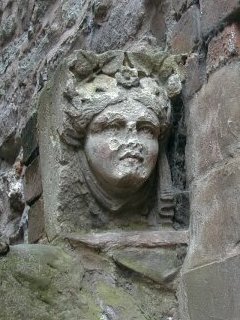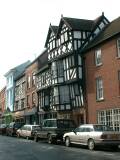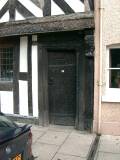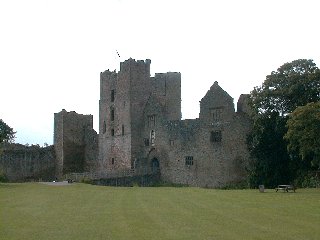 Ludlow is an town in Shropshire (near the Welsh border) where I've
spent a total of just half of a single day (1 September 2000).
Ludlow is an town in Shropshire (near the Welsh border) where I've
spent a total of just half of a single day (1 September 2000). Ludlow is an town in Shropshire (near the Welsh border) where I've
spent a total of just half of a single day (1 September 2000).
Ludlow is an town in Shropshire (near the Welsh border) where I've
spent a total of just half of a single day (1 September 2000).
The town isn't particularly old -- it's not in the Domesday Book -- but it has a notable history. It has been a centre of commerce since the middle ages, originally in cloth, arrows and gloves. From 1536 until 1689, the town was the site of the council of the Lord President of the Marches, and thus in effect the capital of Wales.
Ludlow now has various claims to the attention of guidebooks, among them the very fine misericords in its church. Unlike misericords elsewhere, these are easy to see. Still, I didn't attempt to photograph the church or any of the more or less hidden treasures of the town. On this page you'll find instead the superficial view of the day-tourist.
Ludlow is a bustling little place, with shopping streets --
-- and a market:

 There's also an enormous
number of old buildings. (Numerous web pages say that there are over 500
listed buildings.) Any one of them probably has a history. Here you have a
typical mixture and a single example, the shop named "Pye Powder".
According to a plaque thoughtfully provided by the Ludlow Civic Society,
the latter is:
There's also an enormous
number of old buildings. (Numerous web pages say that there are over 500
listed buildings.) Any one of them probably has a history. Here you have a
typical mixture and a single example, the shop named "Pye Powder".
According to a plaque thoughtfully provided by the Ludlow Civic Society,
the latter is:
The Tolsey; a 15th century courthouse, once open on the ground floor. One of the courts held here was Pye Powder (French 'pieds poudres'), where market disputes were heard whilst 'the dust was on the feet'.
Below, the single most famous building in the centre, an inn called the Feathers.
It's a "prodigy of timber-framed houses" (Pevsner 185), or:
A little above Corve Gate is an antique building known by the name of the Feathers Inn, which has formerly been an elegant mansion. In the mantle piece of one of the front rooms well preserved specimens of carved work remain, from which the traditionary account of its having belonged to one of the Justices of the Court of the Marches is sufficiently confirmed; and the initials I.R. over the royal arms, point out the time of James I. (Wright 173)
The conversion into an inn took place in 1670. Yes, the Feathers is still an inn; according to Baedeker, always authoritative about these matters, it offers "thirty rooms from five shillings, breakfast three shillings, lunch three shillings and sixpence, dinner five shillings and sixpence" (abbreviations expanded). Quote that when you make a reservation for what I believe is now dubbed "Feathers at Ludlow Regal Hotel" (I suppose the Americans and readers of the Daily Mail like the "regal" bit).
 That gem aside, there are numerous
half-timbered buildings, many of them with plentiful carving. On your
left, a more humdrum example -- in a town other than Ludlow, it might
merit its own little entry in a guidebook.
That gem aside, there are numerous
half-timbered buildings, many of them with plentiful carving. On your
left, a more humdrum example -- in a town other than Ludlow, it might
merit its own little entry in a guidebook.
This aspect of Ludlow's architecture is justifiably famous -- at least among people willing to venture beyond London, Oxford, Cambridge, Stratford and Edinburgh -- but I also enjoyed some items of street furniture that could easily be overlooked. Born way back in the old twentieth century, I easily remember when normal intelligent people routinely drank tapwater and dismissed the French habit of paying to lug home bottles of Evian, etc., as a national folly (forgiven in view of the enormous superiority of their food). Now the British, too, eschew free water. That explains the cobwebby, trident-topped beauty you see below -- not an advertisement for Maserati, but a water fountain ("Presented by George Woodhouse, Mayor of Ludlow, 1908"). Perhaps its days are numbered.
Before we go to the castle, a quick look at the Chapel of St Thomas of Canterbury, part of which dates from 1190 (and the rest from the eighteenth century). It's downhill from the centre, and I happened to notice it when walking back to where I'd parked the car.
There's more to the town. Back in 1784, John Byng regarded it as:
one of the best towns for a genteel family of small fortune to retire to that I have ever seen, for it is cheap, well built, and clean, surrounded by a charming country, and river; and affords a theatre, public walks, an assembly once a fortnight, and annual races. (Girouard 105)
 Ludlow's very oldest building is also its most spacious: the
castle. A gloomy-looking place from the outside, to be sure. Care to enter it?
Ludlow's very oldest building is also its most spacious: the
castle. A gloomy-looking place from the outside, to be sure. Care to enter it?
First created: 4 April 2001. Last fiddled with: 5 April 2001.